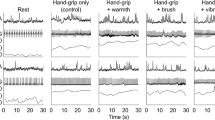Abstract
There are few well-controlled biofeedback temperature training studies in the literature that have used children as subjects. The purposes of this study were (1) to evaluate whether children can learn to increase hand temperature, controlling for methodological factors that have been overlooked in previous experiments, and (2) to determine whether adding thermal biofeedback to autogenic phrases results in improved ability to produce voluntary increases in hand temperature over the use of autogenic phrases alone. Twenty-six subjects (ages 9–11) were divided into two groups of 13 subjects each. All subjects participated in four 35 to 45-minute sessions consisting of a stabilization phase, a training phase, and a post-training phase on 4 consecutive days. One group was trained to increase finger temperature with autogenic phrases only, and the other was trained with autogenic phrases plus thermal feedback. None of the subjects in either group learned to increase hand temperature significantly within sessions. There was a consistent and reliable decreasing trend within each session; however, finger temperature did increase (.27° F) for the first 8 minutes of the training phase. There was a significant increase in hand temperature from day 1 to days 3 and 4, and there were significant increases in temperature during the stabilization phase alone. There were no differential effects of treatments. Methodological issues concerning stabilization, the potential confounding effect of boredom and fatigue, and different training methods for children are discussed.
Similar content being viewed by others
References
Albertstein, B. (1977). Biofeedback and skin temperature control.Psychophysiology, 14 115 (Abstract).
Bille, B. O. (1962). Migraine in school children.Acta Paediatrica, 51(Suppl. 136), 14–151.
Brown, J. K. (1977). Migraine and migraine equivalents in children.Developmental Medicine and Childhood Neurology, 19 683–692.
Diamond, S., & Franklin, M. (1976) Biofeedback—Choice of treatment in childhood migraine.Biofeedback and Self-Regulation, 1 349 (Abstract).
Dikel, W., & Olness, K. (1980). Self-hypnosis, biofeedback and voluntary peripheral temperature control in children.Pediatrics, 66(3), 335–340.
Freedman, R. R., Lynn, S. J., Ianni, P., & Hale, P. A. (1981). Biofeedback treatment of Raynaud's disease and phenomenon.Biofeedback and Self-Regulation, 6(3), 355–365.
Hunter, S. H., Russell, H. L., Russell, E. D., & Zimmerman, R. L. (1976). Control of fingertip temperature increases via biofeedback in learning-disabled and normal children.Perceptual and Motor Skills, 43 743–755.
Keefe, F. J. (1978). Biofeedback vs. instructional control of skin temperature.Journal of Behavioral Medicine, 1(4), 383–390.
Keefe, F. J., & Gardner, E. T. (1979). Learned control of skin temperature: Effects of short-and long-term biofeedback training.Behavior Therapy, 10 202–210.
Keefe, F. J., Surwit, R. S., & Pilon, R. N. (1980). Biofeedback autogenic training, and progressive relaxation in the treatment of Raynaud's disease: A comparative study.Journal of Applied Behavior Analysis, 13(1), 3–11.
Kewman, D., & Roberts, A. (1980). Skin temperature biofeedback and migraine headaches. A double-blind study.Biofeedback and Self-Regulation, 5(3), 324–345.
King, N. J., & Montgomery, R. B. (1980). A component analysis of biofeedback induced self-control of peripheral (finger) temperature.Biological Psychology, 10 139–152.
Lynch, W. C., Hama, H., Kohn, S., & Miller, N. E. (1976). Instrumental control of peripheral vasomotor responses in children.Psychophysiology, 13 219–221.
Ostfeld, A. M. (1963). The natural history and epidemiology of migraine and muscle contraction headache.Neurology, 13 11–15.
Peper, E., & Grossman, E. R. (1974, February).Preliminary observations of thermal biofeedback in children with migraine. Paper presented at a meeting of the Biofeedback Research Society, Colorado Springs.
Prensky, A. L. (1976). Migraine and migrainous variants in pediatric patients.Pediatric Clinics of North America, 23(3), 461–471.
Sargent, J. D., Green, E. E., & Walters, E. D. (1972). The use of autogenic feedback training in a pilot study of migraine and tension headaches.Headache, 12(3), 120–124.
Schultz, J. H., & Luthe, W. (1969).Autogenic therapy (Vol. 1). New York: Grune and Stratton.
Selby, G., & Lance, J. W. (1960). Observations on 500 cases of migraine and allied muscular headache.Journal of Neurology, Neurosurgery, and Psychiatry, 23 23–32.
Surwit, R. S. (1973). Biofeedback: A possible treatment for Raynaud's disease.Seminars in Psychiatry, 5(4), 483–490.
Surwit, R. S., & Fenton, C. H. (1980). Feedback and instructions in the control of digital skin temperature.Psychophysiology, 17(2), 129–132.
Surwit, R. S., Pilon, R. N., & Fenton, C. H. (1978). Behavioral treatment of Raynaud's disease.Journal of Behavioral Medicine, 1(3), 323–335.
Taub, E. (1977). Self-regulation of human tissue temperature. In G. E. Schwartz & J. Beatty (Eds.),Biofeedback, theory, and research. New York: Academic Press.
Taub, E., & Emurian, C. S. (1971).Operant control of skin temperature. Paper presented at Biofeedback Research Society Meeting, St. Louis.
Taub, E., & Emurian, C. S. (1973). Self-regulation of skin temperature using a variable intensity light. In J. Stoyva, T. Barber, L. V. Dicara, J. Kamiya, N. E. Miller, & B. Shapiro (Eds.),Biofeedback and self-control: 1972 (p. 504). Chicago: Aldine (Abstract).
Taub, E., & Emurian, C. S. (1976). Feedback-aided self-regulation of skin temperature with a single feedback locus: 1. Acquisition and reversal training.Biofeedback and Self-Regulation, 1 147–168.
Werder, D. S. (1978). An exploratory study of childhood migraine using thermal biofeedback as a treatment alternative.Proceedings of the Biofeedback Society of America Ninth Annual Meeting, 45–47.
Winer, B. J. (1971).Statistical principles in experimental design. New York: McGraw-Hill.
Zeiner, A., & Pollak, M. (1980). Bidirectional changes in digital skin temperature using biofeedback in a cold room.Journal of Clinical Psychology, 36(2), 514–519.
Author information
Authors and Affiliations
Rights and permissions
About this article
Cite this article
Kelton, A., Belar, C.D. The relative efficacy of autogenic phrases and autogenic-feedback training in teaching hand warming to children. Biofeedback and Self-Regulation 8, 461–475 (1983). https://doi.org/10.1007/BF00998753
Issue Date:
DOI: https://doi.org/10.1007/BF00998753




